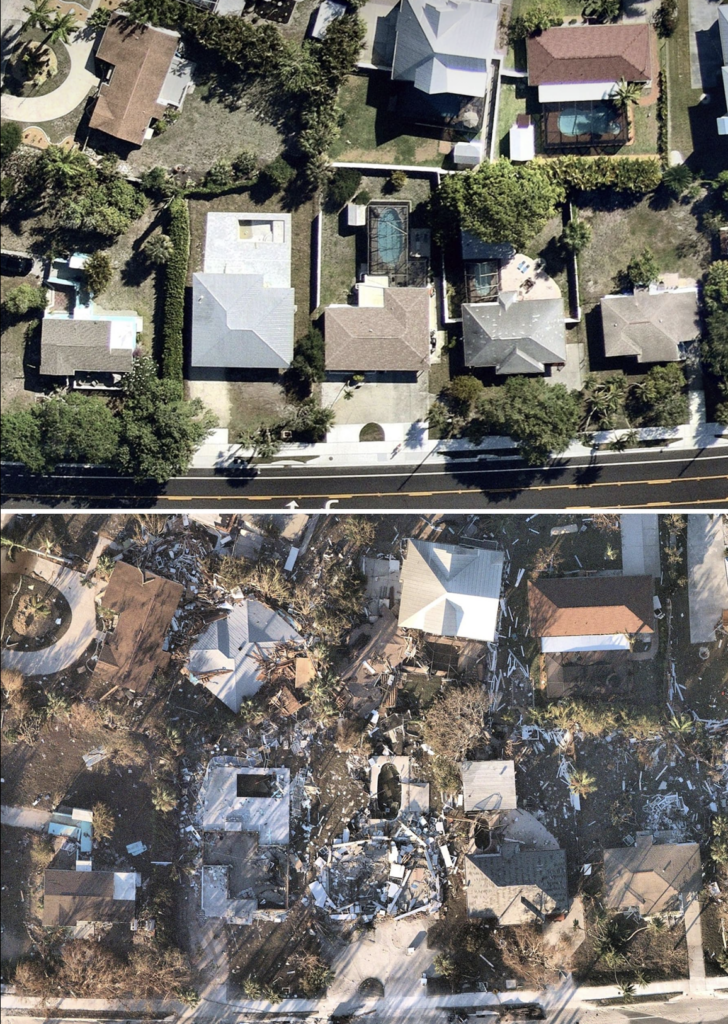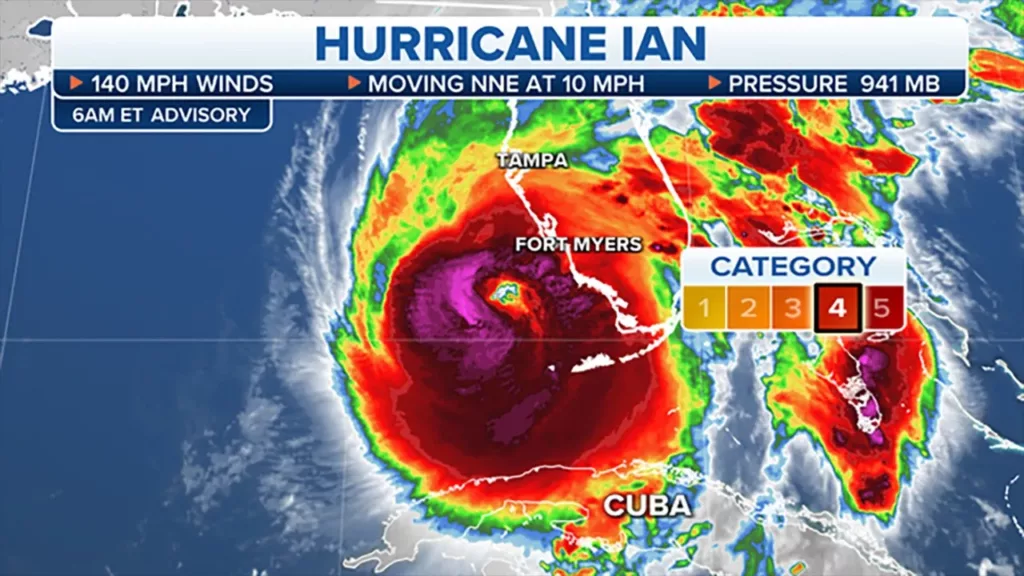Hurricane Ian hit Southwest Florida in September, leaving a trail of destruction in its wake. The hurricane caused significant damage to homes in the affected areas, leaving many homeowners struggling to recover from the impact of Hurricane Ian. We’re based in Lee & Collier County – both of which were absolutely devastated by the storm. One of our founders’ brothers had his home destroyed in the storm. The following is a description of some of the devastation, as well as some options home owners have. use the following to jump to these sections:
Hurricane Ian – The Storm

Homes were destroyed by the powerful winds and storm surge that accompanied Hurricane Ian. Many homeowners lost everything they had, while others were left with severe damage to their homes. The aftermath of Hurricane Ian has been devastating for many families in Southwest Florida.
The damage caused by Hurricane Ian was catastrophic. Homes were ripped apart by the strong winds and heavy rain, leaving many people homeless. The storm surge also caused significant flooding, which further damaged homes and property.
Hurricane Ian was classified as a Category 4 hurricane when it made landfall in Southwest Florida (although after the fact it would be classified as a Category 5). This means that it had sustained winds of between 130-156 mph and would go on to cause catastrophic damage to buildings and infrastructure.
Homestead, Florida was devastated by Hurricane Andrew in 1992. This Category 5 hurricane destroyed thousands of homes and caused billions of dollars worth of damage. However, it is important to remember that every hurricane is unique and can cause different levels of destruction depending on its strength and path. Unlike other storms (I’ve personally experienced more than a dozen including the areas last most devastating storm – Hurricane Charley in 2004) this storm didn’t directly hit the Southwest Florida region – instead it sat off the coast for nearly 12 hours, sweeping Tampa Bay into it’s system and dumping it in the form of coastal swells and rising tides. I know people who lived very far from shore – but unfortunately close to some of the inlets – who received more than 11 feet of water!
If your home has been damaged by Hurricane Ian, there are steps you can take to start the recovery process. Contact your insurance company as soon as possible to file a claim for damages. Take photos or videos of any damage to your home or property, as this will help with your insurance claim.
You may also want to consider hiring a professional contractor or restoration company to assess the damage and begin repairs. Cobia Holdings has a few amazing contractors as a part of our development business – so give us a call or contact us – and we can help get you in touch.
It is important to work with reputable companies who have experience dealing with hurricane damage.
Quantifying the damage caused by Hurricane Ian to homes in Florida
It’s almost immeasurable the damage that was caused by Ian. The storms’ destruction path was very unique, extending as far south as Marco Island and South Naples – all the way to central Florida (as the flooding path caused rivers like the Caloosahatche too raise considerably). Although not as devastatingly QUICKLY powerful – as say a storm like Andrew that devastated the East coast in the 90’s (thanks in part to Florida’s updated building codes) – almost NOTHING can prevent the damage these levels of water can do to property. Continue on for more information quantifying the storm’s destructive power and costs.
Significant Damage Caused by Hurricane Ian to Homes in Florida

Hurricane Ian caused significant damage to homes in Florida, leaving many homeowners with the daunting task of repairing their properties. The category 5 hurricane made landfall on September 10, 2021, and left a trail of destruction across the state. Experts estimate that the total cost of Hurricane Ian’s damage to be approximately 112 Billion! A truly staggering amount. But, as we live right in the epicenter of the destruction – and areas like the WHOLE OF FORT MYERS BEACH were, sadly, wiiped off the map – one can easily see just how devastating and costly this storm was. Take a look at this amazing before & after compilation put on by the Washington Post. Sadly, even 7+ months later, although virtually all of the wreckage is gone – much of the rebuilding is just beginning.
The Majority of Damage Caused by Strong Winds? No… Flooding
The majority of the damage was caused by flooding. Haven’t experienced the devastating power of this storm (as well as many others) wind is always a huge problem (generally damaging roofs and all kinds of other buildings). However, in this case the absolutely DEVASTATING effects of this storm were due to high-tide levels and massive amounts of flooding. Areas along Southwest Florida’s coast – all the way inland in some cases (for example along the Caloosahatchee) were devastated by waters as high as 12+ feet.
Much of Fort Myers beach for example – was wiped out due to this flooding. It’s hard to even imagine – or estimate – the amount of force and power 12+ feet of water rushing in from a storm like this has.
Rebuilding Process Expected to Take Several Years
The rebuilding process is expected to take several years. Homeowners will need to work with contractors and insurance companies to assess the extent of the damage and develop a plan for repairs. Some homes may need extensive renovations or even be rebuilt entirely.
Impact of Hurricane Ian on the Housing Market and Affordability in Florida
Hurricane Ian had a huge impact on the region – really Florida in general – not least of which was the wholesale overhaul of the state’s insurance coverage systems. But in addition to the individual destruction, it’s had an impact on the housing marketing specifically.
Mixed Housing Price Impact
Hurricane Ian had a profound, but mixed impact on the housing market in Florida. The storm caused significant damage to homes, leading to an increase in housing prices in some areas (there was a huge influx of short and long-term buyers and renters immediately following the storm) however, less than year out from the storm, the market has relaxed some bit. Ironically, our “season” was mostly unaffected. One would think that – possibly – due to the devastation of a once in a 1000 year storm crushing this coast – that perhaps people wouldn’t flock down in droves for their Winter vacations. But, alas, we were not so “lucky” – season for 2023 was bigger than ever.
Unfortunately the damage (in some way, shape or form) will persist for years. As homeowners seek to repair or rebuild their damaged properties, demand for construction materials has skyrocketed in the area – as has the need for talented contractors. Luckily, our own team is in-house when it comes to repairs.
In addition to the direct impact on home prices, Hurricane Ian also had an indirect effect on the housing and insurance markets. As many know, DeSantis recently passed new legislation to get flood insurance under control. Our own reading of the bill – mixed. It’s hard to understand the long-term implications the new measures will have on these markets. Short term they make sense and should help, long-term, it’s hard to say if it will have a meaningful and positive impact.
Finally, many residents were displaced by the storm and forced to seek temporary housing elsewhere. This influx of renters put additional pressure on an already tight rental market, causing rental rates to rise as well.
Decreased Availability of Affordable Housing Options
Another consequence of Hurricane Ian was a decrease in the availability of affordable housing options. With so many homes damaged or destroyed by the storm, there simply weren’t enough affordable units available to meet demand. This shortage was particularly acute among low-income households, who struggled to find suitable housing at a price they could afford.
The lack of affordable options led many families to double up with relatives or friends, putting additional strain on existing relationships and living situations. Others were forced into substandard housing conditions or even homelessness as they tried to find a place to live amidst skyrocketing prices.
Long-Term Impact
The impact of Hurricane Ian on the housing market in Florida was felt for years after the storm itself had passed. While home prices eventually stabilized and began to come down somewhat, they still remained elevated compared with pre-storm levels. The shortage of affordable housing options also persisted long after other aspects of life had returned to normal.
As policymakers grappled with these challenges, some solutions emerged. For example, several local governments implemented programs aimed at increasing access to affordable housing through subsidies or tax incentives for developers who built low-income units. Other efforts focused on improving infrastructure resilience so that future storms would be less likely to cause such widespread damage.
Available resources for homeowners affected by Hurricane Ian
General Financial Assistance Disaster Assistance
Homeowners affected by Hurricane Ian can apply for financial assistance through the federal governments disaster assistance website at: https://www.disasterassistance.gov/. This financial aid is available to help homeowners repair their damaged homes and recover from the disaster.
Flood Insurance
Flood insurance is another resource that can provide homeowners with the necessary funds to repair their damaged homes. Homeowners who have flood insurance may be able to receive money for repairs or rebuilding costs. It’s important to note that not all homeowners’ insurance policies cover flood damage, so it’s essential for homeowners to check if they are covered.
Health Coverage Special Open Enrollment
In the wake of the devastation caused by Hurricane Ian, the Department of Management Services (DMS), Division of State Group Insurance (DSGI) will be running a special open enrollment period for employees impacted by Hurricane Ian available via: https://www.mybenefits.myflorida.com/health/hurricane_ian_special_open_enrollment. We understand these employees are rightfully focused on recovery, and we are committed to ensuring they have time and access to make needed benefits changes.
Consumer Financial Protection Bureau List of Available Resources
The CFPB has compiled a list of available resources for homeowners affected by Hurricane Ian through their toolkit at: https://www.consumerfinance.gov/about-us/blog/financial-toolkit-for-victims-of-hurricanes-fiona-and-ian/
Dealing with insurance adjusters after Hurricane Ian damage
Assessing the Damage: Dealing with Insurance Adjusters After Hurricane Ian
When a hurricane damages your home, it is natural to feel overwhelmed and unsure of what steps to take next. One of the most important things you will need to do is work with an insurance adjuster to assess the damage and determine what compensation you are entitled to receive. Here are some tips for dealing with insurance adjusters after Hurricane Ian.
Document Everything Before the Adjuster Arrives
Before the adjuster arrives at your home, it is essential that you document all damages and losses thoroughly. Take photographs or videos of every room in your house, including any damaged furniture, appliances, or personal belongings. Make a list of everything that has been damaged or destroyed, along with its estimated value. Having this information ready when the adjuster arrives will help ensure that nothing is overlooked during their assessment.
Be Wary of Insurance Companies Trying to Minimize Your Claim
Unfortunately, some insurance companies may try to minimize your claim or offer a low settlement in order to save money. It is essential that you do not accept any settlement offers until you have had a chance to review them carefully and consult with an attorney if necessary. Remember that insurance companies are businesses and may not always act in your best interests.
Consider Hiring a Public Adjuster
If you feel like you are not getting the compensation that you deserve from your insurance company’s adjuster, consider hiring a public adjuster to represent your interests during the claims process. Public adjusters work on behalf of policyholders rather than insurance companies and can help ensure that you receive fair compensation for all damages and losses related to Hurricane Ian.
Protecting the working waterfront after Hurricane Ian
The working waterfront is an essential part of our coastal communities, providing economic opportunities and support for local businesses. However, when natural disasters like Hurricane Ian strike, they can cause significant damage to this vital infrastructure. Here are some key talking points about protecting the working waterfront after Hurricane Ian’s storm surge hit coastal areas.
Pine Island and Sanibel Island: Hardest Hit Islands on the Coast
Pine Island and Sanibel Island were among the hardest hit islands on the coast during Hurricane Ian. The storm surge caused extensive damage to homes, businesses, and infrastructure in these areas. In particular, many docks and piers were destroyed or severely damaged by the high winds and waves. This has had a significant impact on local fishermen and other workers who rely on these facilities for their livelihoods.
Fort Myers Beach and Cape Coral: Significant Damage from Storm Surge
In addition to Pine Island and Sanibel Island, Fort Myers Beach and Cape Coral also suffered significant damage from Hurricane Ian’s storm surge. Many waterfront properties were flooded or damaged by the high waters, including restaurants, hotels, and marinas. This has had a ripple effect throughout the local economy as businesses struggle to recover from the disaster.
American Integrity Cargo Ship Incident
During Hurricane Ian’s storm surge, a cargo ship named American Integrity ran aground on the coast near Pine Island. The ship was carrying coal when it became stuck in shallow water due to the high winds and waves. While there were no injuries reported in this incident, it highlights the importance of protecting our coastal infrastructure during extreme weather events like hurricanes.
Octavio Jones & Wheeler Cozza Footage of Storm Impact
Octavio Jones and Wheeler Cozza captured footage of Hurricane Ian’s impact on the waterfront for WINK News. Their footage shows just how devastating this storm was for our coastal communities, with docks ripped apart by powerful waves and boats tossed around like toys in the water. This kind of visual evidence is critical for raising awareness about the importance of protecting our working waterfronts from future storms.
Rebuilding and recovery efforts after Hurricane Ian damage
Community Members Come Together to Rebuild After Hurricane Ian Damage
Rebuilding efforts are underway in Lee County, where Hurricane Ian caused significant damage to homes and structures in the area. The aftermath of Hurricane Ian’s destruction has left many people without homes or everything they thought they had. However, despite this devastation, the community is coming together to assist with recovery efforts.
People have been working tirelessly to clean up debris and rebuild damaged homes. Companies like Johnson and Getty Images have also joined forces with local company Andryanna Sheppard to help rebuild the area. These developers understand that rebuilding after such a disaster takes time, effort, and resources.
The rebuilding process will take years, but with everyone’s help, Lee County can recover from this tragedy. NPR reported that it could take up to a year just for debris cleanup alone. However, the community’s resilience is evident as people band together to support one another during these difficult times.
Developers Provide Resources for Recovery Efforts
More than five months after Hurricane Ian decimated parts of Florida, 25 small businesses in the region are continuing their recovery efforts with some help from a unique partnership between Verizon Business and two non-profits.
Verizon has donated $250,000 to Collaboratory, a local non-profit community problem-solving organization in Southwest Florida, and Florida TaxWatch, a trusted non-profit that promotes economic development across the state that serves as the ‘eyes and ears’ of Florida taxpayers.
Moving forward after Hurricane Ian damage to homes
Moving forward Cobia Holdings will be developing resources for the Hurricane season – something a bit more thorough and digital than the current offerings of the local meteorologists. Be sure to check back often for our guide.



